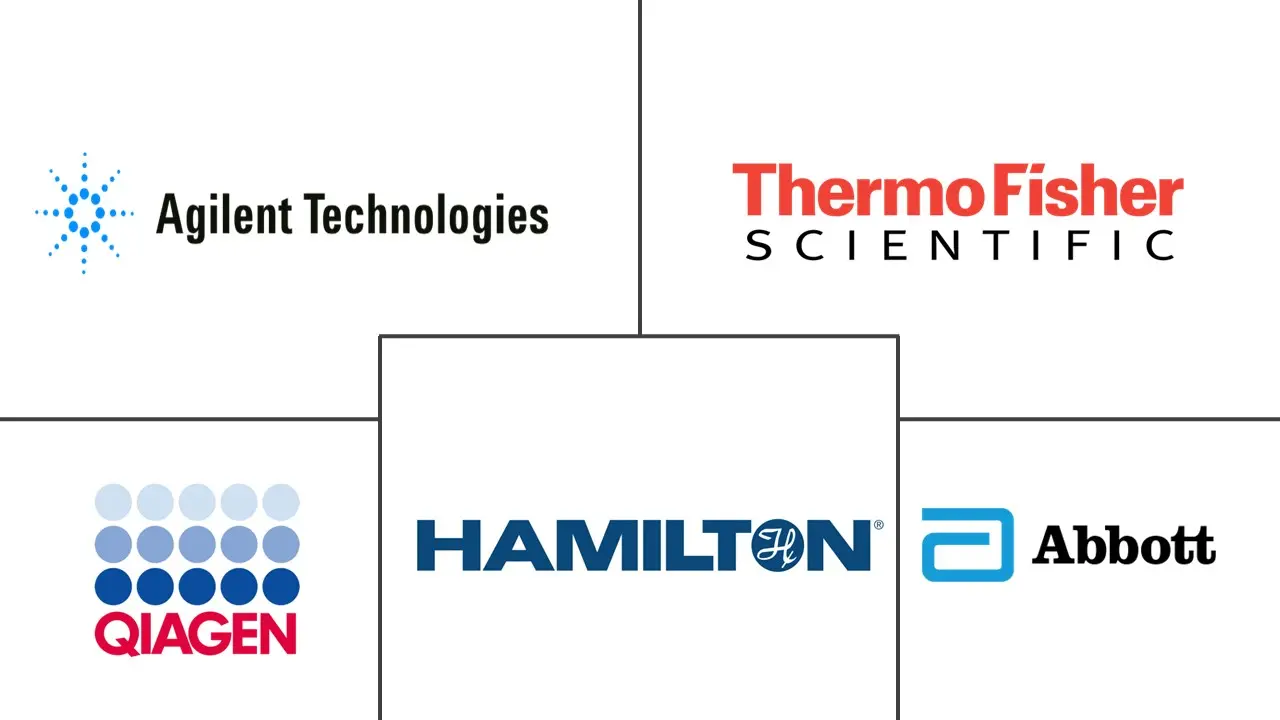Human Identification Market Size and Share
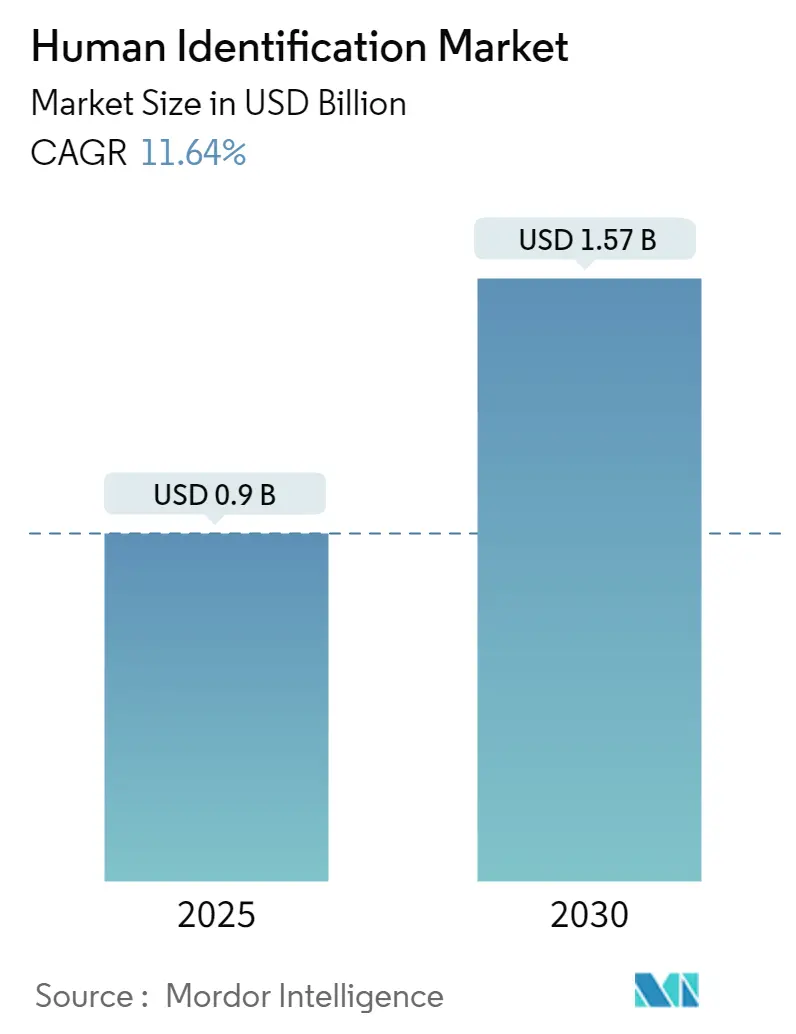
Human Identification Market Analysis by Mordor Intelligence
The Human Identification Market size is estimated at USD 0.90 billion in 2025, and is expected to reach USD 1.57 billion by 2030, at a CAGR of 11.64% during the forecast period (2025-2030).
The human identification industry continues to evolve rapidly, driven by increasing crime rates and the growing need for advanced forensic analysis capabilities. According to the Centers for Disease Control and Prevention (CDC) data from 2022, the United States experienced a significant 30% rise in murder rates, representing the largest single-year increase in more than a century. This surge in criminal activities has led to increased demand for sophisticated human identification technologies across law enforcement agencies worldwide. The field has witnessed a transformation from traditional identification methods to more advanced molecular techniques, particularly in handling complex criminal cases and disaster victim identification.
The industry landscape is being reshaped by breakthrough developments in DNA analysis technologies and automation capabilities. In 2023, forensic laboratories worldwide have increasingly adopted next-generation sequencing (NGS) technologies, enabling the analysis of highly degraded DNA samples and providing more comprehensive genetic information. The integration of artificial intelligence and machine learning algorithms has significantly enhanced the accuracy and speed of DNA profile matching. These technological advancements have particularly benefited cold case investigations and missing persons identification programs, allowing for the processing of previously unusable samples.
Strategic industry collaborations and partnerships have emerged as a key trend shaping the human identification market dynamics. In March 2023, ARUP Laboratories launched an advanced bioinformatics platform called Rio, which has revolutionized next-generation sequencing test results by enabling faster data transfer and more accurate analysis. This platform exemplifies the industry's move toward integrated solutions that combine advanced analytics with traditional DNA testing methodologies. The market has also witnessed increased collaboration between private companies and government agencies to develop standardized protocols for human identification.
The standardization of forensic procedures and quality assurance has become increasingly important in the human identification field. Forensic laboratories worldwide are adopting ISO 18385 certification for human DNA testing products, ensuring minimal contamination risks and maintaining high-quality standards. The industry has also seen a shift toward automated workflows and integrated systems that reduce human error and increase processing efficiency. These developments have been particularly crucial in addressing the growing backlog of forensic cases while maintaining the highest standards of accuracy and reliability in human identification procedures.
Global Human Identification Market Trends and Insights
Technological Advancements in Human Identification System
The human identification market is experiencing significant advancements through revolutionary technologies that enhance the speed and accuracy of DNA analysis. According to research published in Frontiers in Ecology and Evolution in March 2021, methodologies have progressed from traditional gel electrophoresis to sophisticated capillary electrophoresis and next-generation sequencing (NGS). The evolution of these technologies has made it possible to analyze challenging post-mortem samples and obtain appropriate quality and quantity of DNA for identification from putrefied and unidentified dead bodies. These technological improvements have led to the development of new strategies that significantly improve the adoption rate among forensic laboratories and research institutions.
The industry has witnessed numerous breakthrough innovations, particularly in rapid DNA analysis systems that can generate interpretable genetic profiles in under 90 minutes. For instance, in March 2023, Promega Corporation launched the Spectrum CE System, which is compatible with any 5-, 6-, or 8-color STR analysis chemistry for forensic laboratories. This system provides unrivaled flexibility in sample processing using short tandem repeat (STR) analysis by eliminating scheduling challenges and supporting chemistry from key vendors. Additionally, a Stanford-led research team established the first Guinness World Record for the fastest DNA sequencing technique, which was used to sequence the human genome in just 5 hours and 2 minutes, demonstrating the remarkable progress in DNA analysis speed and efficiency.
Increasing Demand for Reducing the Time and Cost of DNA Analysis
The drive to make DNA analysis more accessible and cost-effective has led to significant breakthroughs in the human identification industry. The development of rapid DNA analysis techniques has revolutionized the field by enabling DNA profiles to be generated within two hours while suspects are still in police custody, reducing flight risk and improving investigation efficiency. These advancements have made it possible to process DNA samples more quickly and economically, with some platforms now capable of processing over 18,000 human genomes per year at significantly reduced costs.
The industry has witnessed remarkable progress in cost reduction, with genome sequencing costs dropping dramatically. For instance, the Chinese gene giant BGI Group has revealed plans to make genome sequencing even more affordable, aiming to break the $100 barrier for the first time. This significant cost reduction has been facilitated by innovative technologies and automation processes. Companies like Ultima Genomics have emerged with new high-throughput, low-cost sequencing platforms that deliver the $100 genome, representing a dramatic decrease from the previous $1,000 benchmark set by systems like the HiSeq X Ten. These cost reductions are making DNA analysis more accessible to laboratories of all sizes and enabling wider adoption of human identification technologies.
Government Initiatives and Support
Governments worldwide have significantly increased their support for human identification technologies through various initiatives and funding programs. The Department of Justice's Office of Justice Programs (OJP) has awarded grants totaling more than $210 million to fund crime laboratories, support research, reduce DNA backlogs, and assist law enforcement in locating missing persons. These investments have been crucial in enhancing the accuracy, speed, and reliability of forensic analysis. For example, the Denver Office of the Medical Examiner received a $386,000 federal grant to purchase an in-house rapid DNA processor technology that can produce genetic-test results in hours, allowing for faster identification of victims in mass casualty events.
The implementation of supportive legislation and establishment of specialized facilities demonstrate the growing government commitment to advancing human identification capabilities. In India, the government has launched three fast-track DNA testing units in Mumbai, Nagpur, and Pune under the Nirbhaya scheme for women and child sexual abuse cases. Similarly, the Mexican government has approved the formation of a National Center for Human Identification, while the Australian government has allocated $3.594 million for an Australian-first forensic program to resolve long-term missing person cases. These initiatives not only provide necessary funding but also create frameworks for the standardization and implementation of DNA analysis technologies across various applications, from criminal investigations to disaster victim identification. The human identification analysis software market is poised to benefit significantly from these government initiatives, further driving advancements in the DNA forensics market.
Segment Analysis: By Technology
PCR Segment in Human Identification Market
The Polymerase Chain Reaction (PCR) segment continues to dominate the human identification market, holding approximately 42% market share in 2024. This significant market position is attributed to PCR's widespread adoption in forensic laboratories worldwide due to its reliability and accuracy in DNA profiling. The technology's ability to rapidly produce millions to billions of copies of a specific DNA segment makes it invaluable for various applications, including forensic analysis, paternity testing, and other identification purposes. Modern PCR systems offer enhanced automation capabilities, reduced processing times, and improved accuracy in DNA analysis, making them indispensable tools in human identification laboratories.
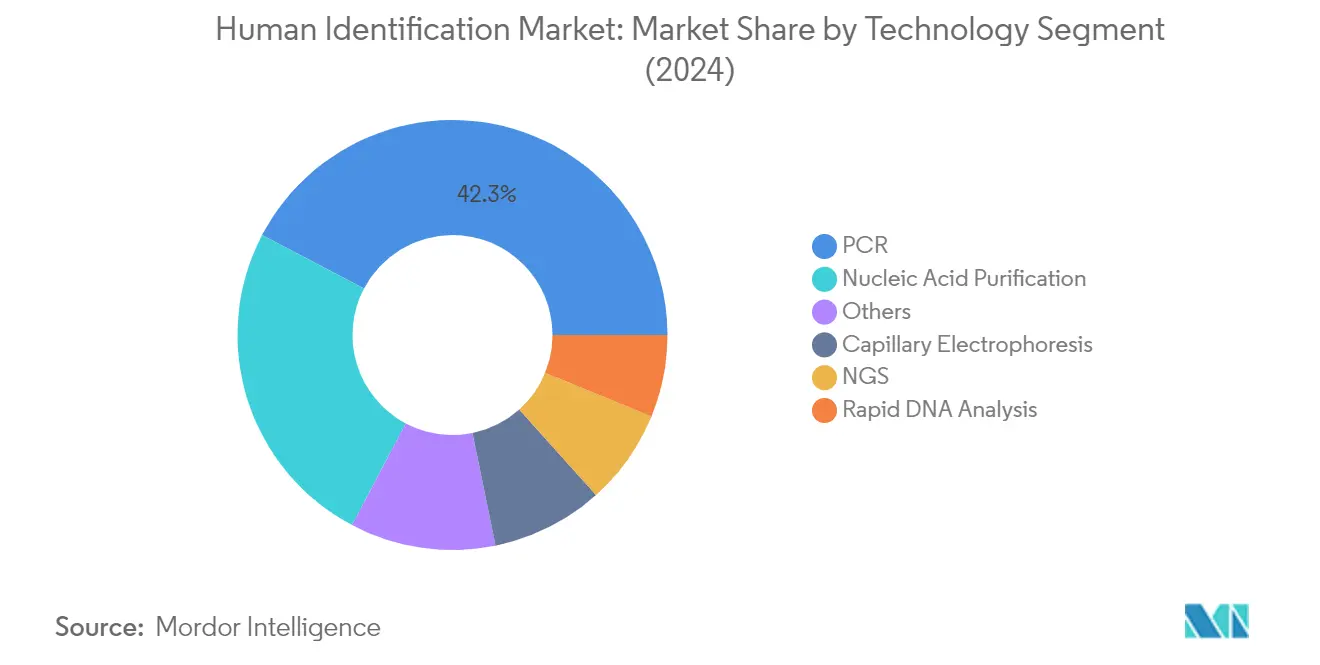
NGS Segment in Human Identification Market
Next Generation Sequencing (NGS) has emerged as the fastest-growing segment in the human identification market, with an expected growth rate of approximately 14% during 2024-2029. The remarkable growth is driven by NGS's superior capabilities in analyzing degraded DNA samples and its ability to provide more comprehensive genetic information compared to traditional methods. The technology's capacity to generate millions of DNA sequence reads simultaneously, while requiring minimal DNA input, makes it particularly valuable for challenging forensic cases. The adoption of NGS is further accelerated by its decreasing operational costs and increasing accessibility to smaller laboratories.
Remaining Segments in Technology
The human identification market encompasses several other crucial technological segments, including Nucleic Acid Purification and Extraction, Capillary Electrophoresis, Rapid DNA Analysis, and various other complementary technologies. Nucleic Acid Purification and Extraction serves as a fundamental step in the DNA analysis workflow, while Capillary Electrophoresis continues to be vital for DNA fragment separation and analysis. Rapid DNA Analysis has gained prominence in law enforcement applications due to its ability to provide quick results in time-sensitive situations. These segments collectively contribute to the comprehensive ecosystem of human identification technologies, each serving specific needs in the identification process.
Segment Analysis: By Products and Services
Assay Kits and Reagents Segment in Human Identification Market
The Assay Kits and Reagents segment continues to dominate the human identification market, holding approximately 50% of the total market share in 2024. This significant market position is attributed to the increasing demand for DNA analysis in forensic applications and paternity testing. The segment's growth is driven by the rising adoption of advanced DNA profiling techniques in criminal investigations and the expanding application of genetic testing in various fields. Major market players are focusing on developing innovative and more efficient assay kits to meet the growing demands of forensic laboratories and research institutions. The segment's dominance is further strengthened by the continuous technological advancements in DNA extraction and analysis methods, coupled with the increasing awareness about the importance of DNA-based identification in legal proceedings.
Software and Services Segment in Human Identification Market
The Software and Services segment is emerging as the fastest-growing segment in the human identification market, with a projected growth rate of approximately 13% during the forecast period 2024-2029. This remarkable growth is primarily driven by the increasing digitalization of forensic laboratories and the rising need for advanced data analysis tools in DNA profiling. The segment is witnessing substantial investments in cloud-based solutions and artificial intelligence-powered software for more accurate and efficient DNA analysis. The growing complexity of forensic investigations and the need for sophisticated data management systems are further propelling the demand for specialized software solutions. Additionally, the increasing focus on quality assurance and standardization in forensic laboratories is creating a strong demand for professional services, including training, consultation, and technical support.
Remaining Segments in Products and Services
The Instruments segment plays a crucial role in the human identification market by providing essential hardware and equipment for DNA analysis. This segment includes various sophisticated devices such as PCR machines, sequencers, and electrophoresis equipment that are fundamental to forensic laboratories and research institutions. The segment's growth is supported by continuous technological innovations in analytical instruments, increasing automation in laboratory processes, and the rising demand for high-throughput systems. Market players are focusing on developing more compact, efficient, and user-friendly instruments to meet the evolving needs of forensic laboratories and research facilities.
Segment Analysis: By Application
Forensic Applications Segment in Human Identification Market
The forensic applications segment continues to dominate the human identification market, holding approximately 65% of the total market share in 2024. This significant market position is primarily driven by the increasing adoption of DNA analysis in criminal investigations, disaster victim identification, and missing persons cases worldwide. The segment's growth is further supported by technological advancements in forensic DNA analysis techniques, including improved DNA extraction methods, rapid DNA analysis capabilities, and the integration of next-generation sequencing technologies. Government initiatives and increased funding for forensic laboratories, coupled with the rising demand for more accurate and efficient criminal identification methods, have also contributed to this segment's market leadership. Additionally, the expanding applications of forensic DNA analysis in cold cases, sexual assault investigations, and mass disaster scenarios have reinforced the segment's dominant position in the human identification market.
Paternity Testing Segment in Human Identification Market
The paternity testing segment is projected to experience the fastest growth in the human identification market during the forecast period 2024-2029, with an expected growth rate of approximately 12%. This accelerated growth is attributed to several factors, including increasing awareness about DNA-based relationship testing, growing legal requirements for paternity verification in child support and custody cases, and the rising number of immigration cases requiring relationship verification. The segment's expansion is further fueled by technological advancements that have made paternity testing more accessible, accurate, and cost-effective. The introduction of non-invasive prenatal paternity testing options and the availability of at-home testing kits have also contributed to the segment's rapid growth. Moreover, the increasing acceptance of DNA testing for genealogical research and the rising number of private laboratories offering paternity testing services have created additional growth opportunities in this segment.
Remaining Segments in Human Identification Market by Application
The other applications segment in the human identification market encompasses various specialized uses of DNA identification technology, including population genetics studies, anthropological research, and archaeological investigations. This segment plays a crucial role in advancing our understanding of human migration patterns, evolutionary history, and genetic diversity across populations. The segment has seen increased adoption in academic research institutions and specialized laboratories focusing on historical and anthropological studies. The application of DNA identification techniques in these areas has contributed to significant discoveries about human origins, ancient civilizations, and population movements throughout history. Additionally, this segment continues to evolve with the integration of advanced genomic technologies and bioinformatics tools, enabling more comprehensive analysis of human genetic variations and their implications for various scientific fields.
Human Identification Market Geography Segment Analysis
Human Identification Market in North America
North America represents the dominant region in the global human identification market, driven by advanced healthcare infrastructure, significant government investments in forensic sciences, and widespread adoption of cutting-edge DNA analysis technologies. The region benefits from well-established regulatory frameworks, the presence of major market players, and increasing applications in forensic investigations. The United States, Canada, and Mexico collectively contribute to the region's market leadership, with each country showing distinct growth patterns influenced by their respective healthcare policies and technological adoption rates.
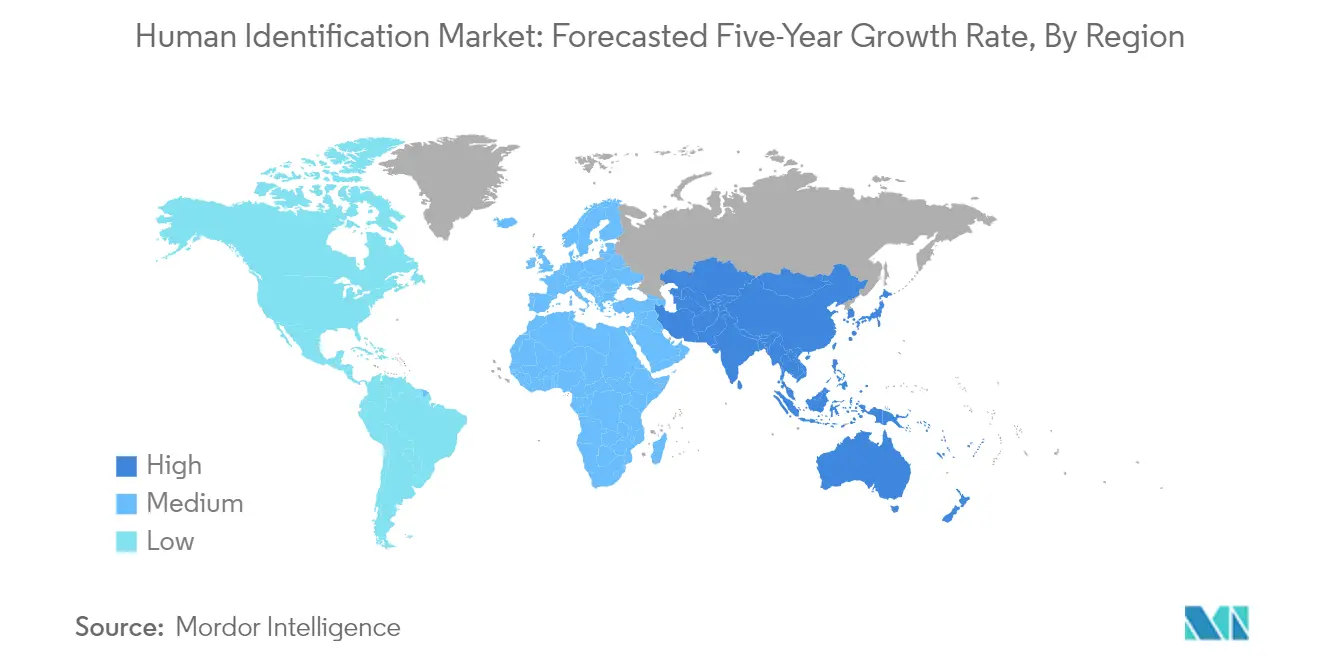
Human Identification Market in the United States
The United States maintains its position as the largest market within North America, commanding approximately 78% of the regional human identification market share. The country's market dominance is attributed to its robust forensic infrastructure, substantial government funding for DNA analysis programs, and the presence of leading biotechnology companies. The FBI's continued support for implementing advanced DNA analysis technologies in law enforcement, coupled with increasing adoption of rapid DNA analysis systems in forensic laboratories, further strengthens the market position. The country's focus on technological advancement in human identification systems and growing demand for reducing DNA analysis time and costs continue to drive market growth.
Human Identification Market in Canada
Canada emerges as the fastest-growing market in North America, with a projected CAGR of approximately 11% from 2024-2029. The country's market growth is driven by increasing adoption of advanced DNA profiling techniques and strong government support for forensic research. Canada's focus on implementing innovative technologies in forensic laboratories and growing investments in research and development activities contribute to its rapid market expansion. The country's emphasis on developing its genomics infrastructure and increasing collaborations between research institutions and industry players are expected to maintain this growth momentum over the forecast period.
Human Identification Market in Europe
Europe represents a significant market for human identification technologies, characterized by sophisticated healthcare infrastructure and a strong emphasis on forensic sciences. The region's market is driven by increasing government initiatives, growing adoption of advanced DNA analysis techniques, and rising demand for forensic applications. Germany, the United Kingdom, France, Italy, and Spain are the key contributors to the regional market, each with distinct market dynamics and growth patterns influenced by their respective healthcare policies and technological adoption rates.
Human Identification Market in Germany
Germany stands as the largest market in Europe, holding approximately 20% of the regional human identification market share. The country's market leadership is supported by its advanced healthcare infrastructure, strong presence of biotechnology companies, and significant investments in forensic research. Germany's focus on implementing innovative DNA analysis technologies and growing adoption of next-generation sequencing techniques in forensic laboratories contribute to its market dominance. The country's emphasis on technological advancement and increasing government support for forensic science programs continue to strengthen its market position.
Human Identification Market in the United Kingdom
The United Kingdom demonstrates the highest growth potential in Europe, with a projected CAGR of approximately 14% from 2024-2029. The country's rapid market growth is driven by increasing adoption of advanced DNA analysis technologies and strong government support for forensic science programs. The UK's focus on implementing innovative forensic techniques and growing investments in research and development activities contribute to its market expansion. The country's emphasis on developing its forensic infrastructure and increasing collaborations between academic institutions and industry players are expected to maintain this growth trajectory.
Human Identification Market in Asia-Pacific
The Asia-Pacific region represents a rapidly evolving market for human identification technologies, characterized by increasing investments in healthcare infrastructure and growing adoption of advanced DNA analysis techniques. The region's market is driven by rising government initiatives, growing awareness about forensic technologies, and increasing applications in criminal investigations. China, Japan, India, Australia, and South Korea are the key contributors to the regional market, each demonstrating unique growth patterns and market dynamics.
Human Identification Market in China
China emerges as the largest market in the Asia-Pacific region, driven by significant investments in forensic infrastructure and growing adoption of advanced DNA analysis technologies. The country's market leadership is supported by increasing government initiatives, rising demand for forensic applications, and the presence of major biotechnology companies. China's focus on implementing innovative technologies in forensic laboratories and growing emphasis on research and development activities continue to strengthen its market position.
Human Identification Market in India
India demonstrates the highest growth potential in the Asia-Pacific region, driven by increasing investments in forensic infrastructure and growing adoption of advanced DNA analysis technologies. The country's rapid market growth is supported by government initiatives to modernize forensic laboratories, rising demand for DNA analysis in criminal investigations, and growing awareness about forensic technologies. India's focus on developing its forensic infrastructure and increasing collaborations between research institutions and industry players are expected to maintain this growth momentum.
Human Identification Market in Middle East & Africa
The Middle East & Africa region demonstrates growing potential in the human identification market, characterized by increasing investments in healthcare infrastructure and rising adoption of forensic technologies. The market is driven by government initiatives to modernize forensic laboratories, growing awareness about DNA analysis technologies, and increasing applications in criminal investigations. Within the region, GCC countries represent the largest market, while South Africa emerges as the fastest-growing market, supported by increasing investments in forensic infrastructure and growing adoption of advanced DNA analysis technologies.
Human Identification Market in South America
South America shows promising growth in the human identification market, driven by increasing investments in forensic infrastructure and rising adoption of advanced DNA analysis technologies. The market is characterized by growing government initiatives, rising awareness about forensic technologies, and increasing applications in criminal investigations. Brazil emerges as the largest market in the region, while Argentina demonstrates the fastest growth potential, supported by increasing investments in forensic infrastructure and growing adoption of advanced DNA analysis technologies.
Competitive Landscape
Top Companies in Human Identification Market
The human identification market is characterized by intense innovation and strategic developments from key players, including Thermo Fisher Scientific, QIAGEN, Promega Corporation, and Bio-Rad Laboratories. Companies are heavily investing in next-generation sequencing technologies and automated DNA analysis systems to enhance processing speed and accuracy. The competitive landscape shows a strong focus on developing cost-effective DNA profiling solutions and rapid DNA analysis capabilities. Strategic partnerships and collaborations, particularly between technology providers and forensic laboratories, have become increasingly common to expand market reach and enhance service offerings. Companies are also emphasizing the development of integrated workflows and comprehensive solutions that combine sample preparation, sequencing, and analysis capabilities. Product portfolios are being expanded to include specialized kits for challenging forensic samples and high-throughput processing systems, reflecting the industry's drive toward more sophisticated human identification solutions.
Consolidated Market Led By Global Leaders
The human identification market demonstrates a relatively consolidated structure dominated by large multinational corporations with extensive research and development capabilities. These established players leverage their broad geographic presence and comprehensive product portfolios to maintain market leadership, while smaller specialized companies focus on niche applications and regional markets. The market shows a clear distinction between full-solution providers offering end-to-end identification systems and specialized companies focusing on specific components or services within the workflow. Merger and acquisition activities are primarily driven by larger companies seeking to acquire innovative technologies or expand their geographic footprint, particularly in emerging markets.
The competitive dynamics are shaped by the presence of both diversified life science companies and specialized forensic technology providers. Major players are increasingly focusing on vertical integration strategies to control key aspects of the value chain, from reagent manufacturing to software solutions. Regional players maintain their relevance through strong local relationships and customized solutions for specific market needs. The industry has witnessed strategic collaborations between technology companies and academic institutions to advance research and development efforts, while also seeing partnerships between manufacturers and distributors to enhance market penetration.
Innovation and Integration Drive Future Success
Success in the human identification market increasingly depends on companies' ability to develop integrated, automated solutions that reduce processing time and costs while maintaining accuracy. Market leaders are focusing on expanding their technological capabilities through internal development and strategic acquisitions, while emerging players are finding opportunities in specialized applications and regional markets. The ability to provide comprehensive support services, including training and validation assistance, has become crucial for maintaining customer relationships. Companies must also navigate complex regulatory requirements across different regions while ensuring their solutions meet evolving forensic standards and quality requirements.
Future market success will be determined by companies' ability to address the growing demand for rapid, portable identification systems while maintaining high accuracy standards. Players must invest in developing user-friendly interfaces and automated workflows to address the shortage of skilled professionals in the field. The increasing focus on data security and privacy compliance will require companies to enhance their software solutions and data management capabilities. Additionally, successful companies will need to demonstrate the cost-effectiveness of their solutions while providing flexible deployment options to meet varying customer needs. The ability to adapt to changing regulatory requirements and maintain strong relationships with law enforcement and forensic laboratories will remain crucial for long-term success in this market.
Human Identification Industry Leaders
-
Thermo Fisher Scientific Inc.
-
Hamilton Company
-
QIAGEN
-
Agilent Technologies,Inc.
-
Abbott Laboratories
- *Disclaimer: Major Players sorted in no particular order
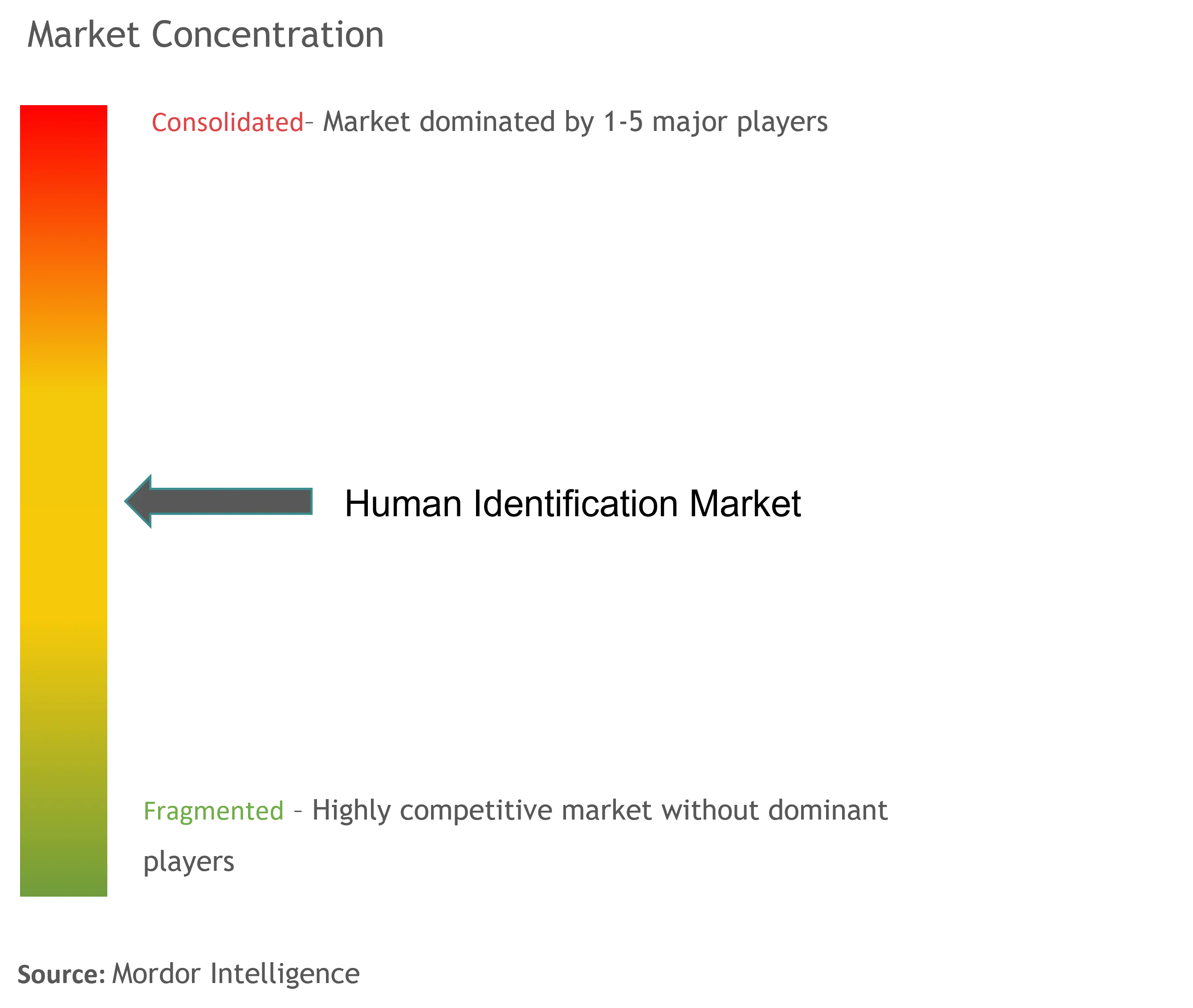
Recent Industry Developments
- May 2022: the Denver Office of the Medical Examiner received a USD 386,000 federal grant to purchase an in-house rapid DNA processor - technology that can produce genetic-test results in a matter of hours, allowing for faster identification of victims in mass casualty events or assisting in the identification of family members of unidentified bodies.
- January 2022: a Stanford-led research team established the first Guinness World Record for the fastest DNA sequencing technique, which was used to sequence the human genome in 5 hours and 2 minutes.
Global Human Identification Market Report Scope
As per the scope of the report, human identification is a technology used to identify specificity from genetic materials. Several companies in the market specifically provide a DNA platform, which can be used in various applications. The Human Identification Market is Segmented by Technology (Polymerase Chain Reaction (PCR), Next Generation Sequencing (NGS), Nucleic Acid Purification and Extraction, Capillary Electrophoresis, Rapid DNA Analysis, and Other Technologies), Product & Service (Instruments, Assay Kits and Reagents, and Software and Services), Application (Forensic Applications, Paternity Testing, and Other Applications), and Geography (North America, Europe, Asia-Pacific, Middle East and Africa, and South America). The report also covers the estimated market sizes and trends for 17 countries across major global regions. The report offers the value (USD million) for the above segments.
| Polymerase Chain Reaction (PCR) |
| Next Generation Sequencing (NGS) |
| Nucleic Acid Purification and Extraction |
| Capillary Electrophoresis |
| Rapid DNA Analysis |
| Other Technologies |
| Instruments |
| Assay Kits and Reagents |
| Software and Services |
| Forensic Applications |
| Paternity Testing |
| Other Applications |
| North America | United States |
| Canada | |
| Mexico | |
| Europe | Germany |
| United Kingdom | |
| France | |
| Italy | |
| Spain | |
| Rest of Europe | |
| Asia-Pacific | China |
| Japan | |
| India | |
| Australia | |
| South Korea | |
| Rest of Asia-Pacific | |
| Middle East and Africa | GCC |
| South Africa | |
| Rest of Middle East and Africa | |
| South America | Brazil |
| Argentina | |
| Rest of South America |
| By Technology | Polymerase Chain Reaction (PCR) | |
| Next Generation Sequencing (NGS) | ||
| Nucleic Acid Purification and Extraction | ||
| Capillary Electrophoresis | ||
| Rapid DNA Analysis | ||
| Other Technologies | ||
| By Product & Service | Instruments | |
| Assay Kits and Reagents | ||
| Software and Services | ||
| By Application | Forensic Applications | |
| Paternity Testing | ||
| Other Applications | ||
| Geography | North America | United States |
| Canada | ||
| Mexico | ||
| Europe | Germany | |
| United Kingdom | ||
| France | ||
| Italy | ||
| Spain | ||
| Rest of Europe | ||
| Asia-Pacific | China | |
| Japan | ||
| India | ||
| Australia | ||
| South Korea | ||
| Rest of Asia-Pacific | ||
| Middle East and Africa | GCC | |
| South Africa | ||
| Rest of Middle East and Africa | ||
| South America | Brazil | |
| Argentina | ||
| Rest of South America | ||
Key Questions Answered in the Report
How big is the Human Identification Market?
The Human Identification Market size is expected to reach USD 0.90 billion in 2025 and grow at a CAGR of 11.64% to reach USD 1.57 billion by 2030.
What is the current Human Identification Market size?
In 2025, the Human Identification Market size is expected to reach USD 0.90 billion.
Who are the key players in Human Identification Market?
Thermo Fisher Scientific Inc., Hamilton Company, QIAGEN, Agilent Technologies,Inc. and Abbott Laboratories are the major companies operating in the Human Identification Market.
Which is the fastest growing region in Human Identification Market?
Asia-Pacific is estimated to grow at the highest CAGR over the forecast period (2025-2030).
Which region has the biggest share in Human Identification Market?
In 2025, the North America accounts for the largest market share in Human Identification Market.
What years does this Human Identification Market cover, and what was the market size in 2024?
In 2024, the Human Identification Market size was estimated at USD 0.80 billion. The report covers the Human Identification Market historical market size for years: 2019, 2020, 2021, 2022, 2023 and 2024. The report also forecasts the Human Identification Market size for years: 2025, 2026, 2027, 2028, 2029 and 2030.
Page last updated on:
